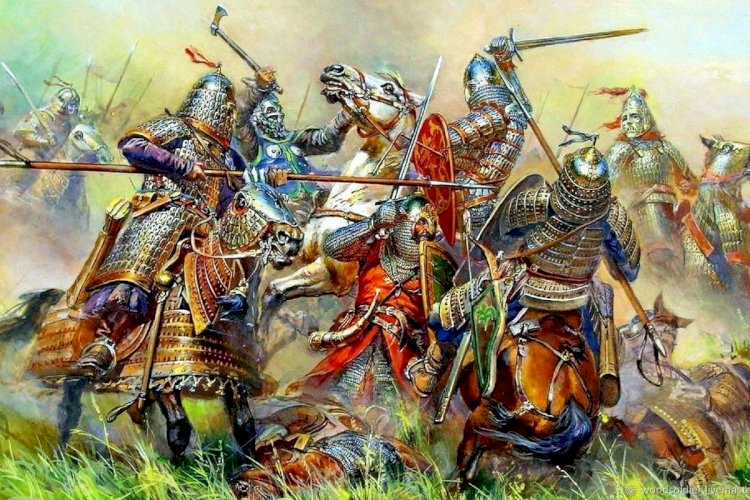On the basis of the mere fact that Russian chronicles called the Kypchaks Polovtsians, an entire branch of mythology was formed.
The previous article «Polovtsian portrait» was devoted to the topic of ethnographic appearance of true historical Kipchaks and invented bylin-historiographic image of «Polovtsians». The artificiality of the term «Kipchaks» as an exo-ethnonym imposed on the Kipchaks, i.e. an external invented name, was revealed. In connection with the artificiality of the original term, the mythology created on its basis was criticized. «Academists», in fact, constructed a whole branch of false ethnonymy and folkloristics out of their own «expert» misconceptions.
The fatal «mistake in the term» entailed the distortion of the ethnic image of the historical people. And, as always, one lie entailed another, and even bigger lie. After all, Internet folklorists, born by «academicians», did not refine themselves in this lie, calling the Kipchaks not only total red-haired, but even yellow-faced.
By the way, the academic «mistake» created not only a «yellow-faced» people, but also gave rise to another folklore-historical extreme of the ethnic description of the Asian people Kipchaks. «Folks» agreed to some blond Caucasoids — allegedly Asian Slavic-Russes, who were the founders of the Eurasian civilization of nomads. And this lie became even ideologically aggressive, belittling the contribution of Asian peoples in the creation of the Great Eurasian Turkic civilization. Adherents of this chauvinistic ideology flooded various «zen» and websites, where they actively impose some blue-eyed blondes as ancestors of Kazakhs! However, this empty Slavic-European fantasy of «folklorists» let’s discard it without wasting time on it. And let’s talk about really red-haired Asia.
Euro-Asian myths
The very fact of the Asian origin of the Kipchak people destroys at the root numerous myths that once in the Asian steppes allegedly ruled some mythical blond Kipchak «blondes». The Asianness of the Kipchaks is indisputable and this is the first fact.
The second argument destroying the fictions of academicians and folklorists is the work of archaeologists and anthropologists that in the Kypchak burials any «outstanding» Caucasoidity was not recorded. The third argument is the material heritage of the Kipchaks in the form of balbals, one look at which is enough to fix the Asianness of the Kipchaks. By the way, only in the Black Sea region and in Ukraine hundreds of balbals have been preserved and all of them are of Asian appearance. Once there were many thousands of them, but some of them were destroyed by vandals, some of them lay in the foundations of later buildings and the base of roads. By the way, a few years ago another Kypchak statue was found in the deep water of a pond in Ukraine.
The fourth antithesis is the Slavic mythology itself. It interprets the name balbal as «baba», giving them a feminine essence from their Slavic name. Here there is the same «mistake in the term» as with the term «Kipchaks». What we know reliably: the sculptures were made by Kipchak Turks. However, why would the Kipchaks name their monuments with the Slavic designation of a woman?! And here again folklore inventions are revealed, as all Turkic ethnography testifies that «baba» is a Turkic name of the ancestor.
Nevertheless, on the basis of the mere fact that Russian chronicles called the Kipchaks Polovtsians, a whole branch of mythology was formed. What we have «in the dry residue»: interpreters once attributed to the Kypchaks a name alien to the Turks. A couple of similar words from other, moreover, Western Slavic languages were added to this external nickname (that is, they simply collected all similar and concealed other meanings of the word «chaff») and the myth appeared. And from this alien, actually, to the Kypchaks themselves interpretation of their never existed Polovtsian self-name, that is from exo-ethnonym, the wave of Indo-Europeanization of the famous people of the history of Asia «went uphill». Kypchaks turned into «redheads», as if the nomads lacked other insinuations in their historical memory.
The red-haired warriors of Asia
Of course, red-haired types or brown-haired men are no surprise to anyone in Middle Eurasia. Moreover, the greatest warriors of the past — Attila, Genghis Khan, Tamerlane — are considered red-haired. Among the Chingizid heirs of the Great Kypchak Horde, the Kazakh khans Togum and his nine sons were red-haired, and they are recorded in history as the dynasty «Togyz-sary» — «nine redheads», and the last Kazakh khan Kenesary, who seemed to embody the spirit of Genghis Khan himself. Here they were red-haired. However the main part of Chinggisids, according to historical records, was still brunettes.
Then according to the law of analogy, if only a part of the Genghisid clan was red-haired, and the main part was brunettes, it gives rise to the ethnographic rule (let’s call it «the rule of ethnographic analogy») that those who came from deep Asia were mostly brunettes, but in some part — and shatens (along with some part of redheads). This rule can be extended to other Turkic clans and peoples. Then on the basis of this historical generalization reasonable looks the conclusion that among all Turkic clans and in general among all peoples of the world some part of them can be both light-haired, and black-haired, but all in no way can be identical. Moreover, in all Turkic and other peoples there is a mixture of different ethnographic images, that is confirmed by complex ethnogenesis of any people, no matter — in Asia or in Europe.
And this rule, apparently, is universal. So, for example, among the standard «Aryan» Germans of Germany, blond individuals make up only 12 percent of the population. And then the question arises: so where did the solid red hair come from among not European, but among profoundly Asian people? The answer is one — from «academic misconceptions» and «folkloric inventions». This proves that total redheadedness (or even more so blondness) did not exist among any people in either Asia or Europe.
In spite of this, the Europocentrists in the description of the Kipchaks have crossed any boundary of reasonableness, because among the Asian peoples there was never that excessive «excess of redheads», which was attributed to the Kipchaks. All Kipchaks, that Sary-Kipchaks, that Kara-Kipchaks, that «and others», constituted one not just ethnographic and ethnopolitical community, but one racial community of Asian appearance.
Therefore, the Europeanization of historical Asians is nothing but hidden racism. It is precisely this racism that emerges and especially overflows over the edge of reasonableness in the myths about certain blue-eyed and fair-haired peoples, who alone could create civilizations in deep Asia. In view of this it is necessary to find out what is the phenomenon, which we will conditionally call: «Red Eurasia».

Historiographic Red Eurasia
In this topic we will try to at least partially illuminate the question of the «red-haired» peoples of Asia, what is this phenomenon on the example of the ancestors of the Turkic peoples.
And if the question arose about the total red-hairedness of the historical people of Kypchaks, then we should turn to the historical evidence that Kypchaks (as well as other Turks) have in their ancestors some red-haired peoples of antiquity. And if, as they say, there is no rumor without grounds, then it is necessary to consider these «grounds», and also to find out how grounded they are (pardon the tautology here).
The Chinese chronicles are the first to inform us about some «red-haired» Turkic peoples on the example of ancient Usuns of the first century AD. They are mentioned in the chronicle Han-shu. But interesting here is a later comment to the Han chronicle, made in the times of the Tang half-Turkic dynasty Yan Shigu: «Usun has the strangest appearance…». Today’s Hu people, blue-eyed and red-bearded, who have the appearance of macaques, were originally their descendants.»
Interesting and sort of contradicting the above red-beardedness is the description of that part of the Xiongnu (Hunnu) people who founded the empire of the Late Zhao Dynasty (in 319-351) in what is now North China. These Huns are considered to be a Caucasoid ethnos. Such their appearance is recorded at the overthrow of this nomadic dynasty. Having overthrown the power of nomads, the Chinese rebels organized genocide to imperials on an ethnic basis. Two hundred thousand people who differed from the Chinese population by «high nose bridge and thick beards» were exterminated. Including those Chinese who had external «Caucasoid» resemblance to the Imperials were also killed.
And here we note that there is no evidence of red hair of Hunnusians. And if there were, the chronicler would certainly have noted them, since he mentioned the height of the bridge of the nose and the thickness of the beard. In connection with nose-beards in historical retrospect we see the supposed portrait of the Europoid tribes of the Jungians who once inhabited northern China. And in our modernity, approaching the area of extermination of the Zhaos, we see modern Uighur Turks, belonging to southern Caucasoids, but without any total redness, and the Ainu ethnicity from the Japanese Islands.
Following the Zhao Huns, the phenotype of the ancient Yenisei Kirghiz is mentioned. According to the chronicle Xin Tang-shu the Kirghiz (qigu): «Their language and writing were identical to Uyghur…All the people are tall and large. They have red hair, white faces and green eyes». This is also confirmed by the unquestionable authority of Bichurin (to whose translations we shall yet turn not only in this topic), who pointed out that: «According to Chinese reports, the Kirghiz were distinguished by their tall stature, red hair, ruddy face and blue eyes».
Also here we find a direct indication that the Kirghiz of the Yenisei and the Syrs of Mongolia (future Kipchaks) are Turks. Briefly, let us pay attention to the fact that both the Yenisei Kirghiz and Syrs, the ancestors of the Kipchaks, are Turks, but their direct consanguinity is not reported. That is, if one Turkic ethnos was presumably red-haired, the second was not necessarily the same red-haired (similar ethnographic heterogeneity, by the way, we observe among modern Turkic peoples).
However, here appears the message of the Chinese source Ganmu, to which adherents of Euro-Kypchaks like to refer, that the people named «Kincha (Kipchak) was blue-eyed and red-haired».
And here we apply the above-mentioned rule of ethnographic analogy that there are not and, obviously, there never were uniformly red-haired or black-haired peoples and ethnoses. And in our case, the Kipchaks were not just an ethnos or a people. The Kipchaks from the moment of their origin were a super-ethnos, dominating from the Danube to the Irtysh and including and mixing in its composition many Turkic ethnic subdivisions of Inner Eurasia. Therefore, the selection of exclusively red-haired people in the composition of the Polovtsians (or higher: Hunnu, Kirghiz or Kincha-Kypchaks) seems impossible.
As a conclusion: it is quite possible that some clans of rulers or clan divisions of ancient Turkic peoples could be red-haired, though not all of them. Although, rather, they had to be shatenes, whose red hair became an exceptional ethnic distinction for the Chinese, shocking them, because among the Chinese no one will mention such a thing. Thus, the exceptional red-hairedness of some clans-ethnoses of ancient Turks is a chronicle exaggeration…..
